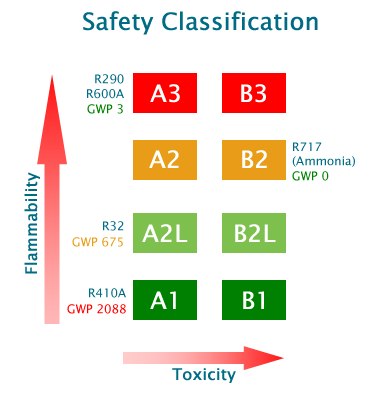Refrigerant safety
Summary
- Refrigerants have toxicity and flammability ratings. The mini-split air conditioners sold in the UK usually contain R32 refrigerant which is rated ’lower toxicity’ and ’lower flammability’. Checkmark recommends you don’t use highly flammable R290 propane based mini-split systems.
- There are room size limits for each refrigerant to help prevent toxic or flammable concentrations of gas in the event of a leak. Most R32 mini-splits installed by DIYers will contain less than 1.8 kg of refrigerant, meaning there are no room size concerns. See room size details below.
The details below are for those who want to learn more about refrigerant safety.
Toxicity and flammability
There are many different refrigerants, each identified by an ‘R’ number - e.g. R32, R410A, R717. Each have their own characteristics and applications, and importantly, a rating of their toxicity and flammability. This rating is a letter-number combination, for example A1 or A2L.
The letter represents toxicity and the number flammability:

Toxicity ratings of refrigerants are either A or B:
- A - Lower toxicity (no identified toxicity at concentration lower than 400ppm)
- B - Higher toxicity (evidence of toxicity below 400ppm)
Flammability classifications are 1, 2L, 2 or 3:
- 1 - No flammability (no flame propagation when tested at 60°C and 101 kPa)
- 2L - Lower flammability (exhibits flame propagation when tested at 60°C and 101 kPa and have a maximum burn velocity of 10cm/s when tested at 23°C and 101 kPa)
- 2 - Flammable (exhibits flame propagation when tested at 60°C and 101 kPa)
- 3 - Higher flammability (exhibits flame propagation when tested at 60°C and 101 kPa)
It would be rare to see the toxicity ‘B’ rating outside industrial applications (e.g. R717, Ammonia, has a rating of B2L).
R32 and some other modern lower GWP (global warming potential) refrigerants are A2L rated and are referred to as ‘A2L refrigerants’. Tools and equipment used should be rated for A2L.
More details at ANSI/ASHRAE Standard 34 
Higher flammability refrigerants
There are some (usually lower-end) mini-split units on the market that use A3 refrigerants - typically R290 (propane) or R600a (isobutane).Checkmark does not recommend these because we wouldn’t be happy with them in our homes. Both R290 and R600a are effectively blowtorch gas, being pumped under high temperature and pressure around the system.
Room size
There are safety standards (BS EN378) on the amount of refrigerant allowed in a system given the volume of air in a room. This is to help prevent toxic or flammable gas mixtures reaching dangerous levels should there be a leak. A risk assessment should be undertaken.
For R32 refrigerant mini-split systems, the total amount of refrigerant in the system should be obtained from the system specifications. This, plus any additional refrigerant for additional pipework, is called the system charge size. This must never exceed the amounts in the following table:
| Room size | Wall mounted | Ceiling mounted |
|---|---|---|
| 9m2 | 3.77kg | 3.09kg |
| 12m2 | 3.56kg | 4.35kg |
| 18m2 | 4.36kg | 5.33kg |
| 24m2 | 5.04kg | 6.16kg |
| 30m2 | 5.63kg | 6.88kg |
| 36m2 | 6.17kg | 7.54kg |
| 42m2 | 6.66kg | 8.15kg |
The calculation should be based upon the smallest room the pipes pass through.
For systems with less than 1.8kg system charge size there are no room volume restrictions. This should include most mini-split systems.
More details are available at:
- The Refcom website
- The Toshiba Air-con website
- a useful set of tables in Q22 of the FAQ
- The HRP website
- a PDF with details of the maths
- The Logic4Training website
- a detailed PDF
Other refrigerants
R32 is the most popular refrigerant in new mini-split systems in the UK, which is why it is the focus of this page. For refrigerants other than R32, see the BS EN378 safety standard.
Some small systems use R290 Propane or R600A Isobutane refrigerants. The charge limits for a given room size on these systems is much lower because they are highly flammable - they’re rated A3. For example, a 3m x 3m room has a R290 maximum charge of just 0.23kg (230g), compared to 3.09kg for R32. There are more details in this ACR Journal article 
Checkmark do not recommend any A3 highly flammable refrigerants - see above.
Refrigerants can cause injury
As well as being illegal to handle unless qualified, it is important to know that most refrigerants can cause ‘cold burns’.Liquid refrigerants under pressure in a system quickly evaporate at room temperature and pressure, taking heat from whatever is close. If this is skin or flesh, serious cold burns can result.